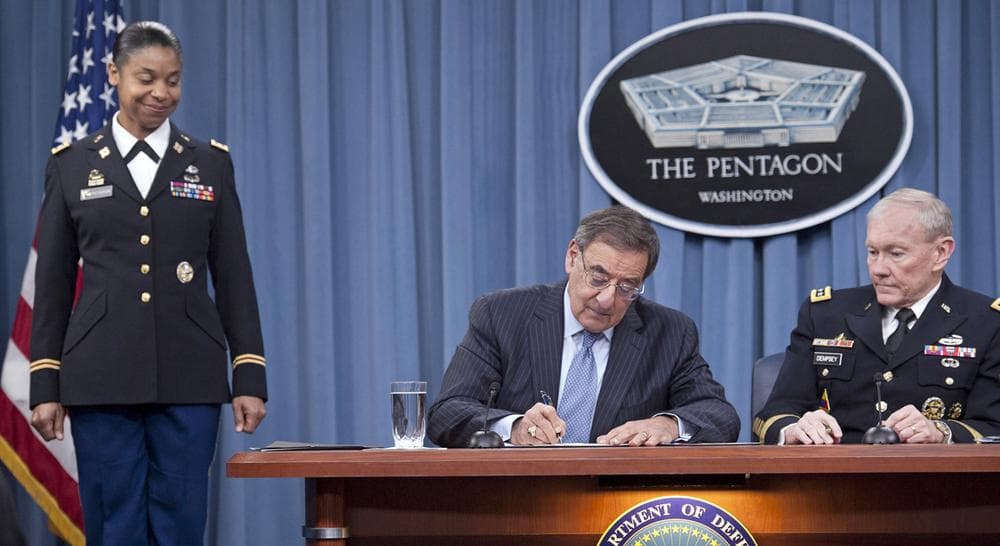Advertisement
Women In Combat: Whatever Barriers To Equality Remain, This Is A Moment To Savor
“The principle that women should not intentionally and routinely engage in combat is fundamental and enjoys wide support among our people,” a Senate Armed Services Sub-Committee reported in 1980.
That was then.
Today a strong majority of “our people” (some 73 percent) support the opening of combat roles for women.
This shift in opinion isn’t entirely surprising. Women have been at war alongside men for the past ten years. As Defense Secretary Leon Panetta observes, men and women “are fighting and they’re dying together.” It’s time for regulations to catch-up with reality.
Indeed, you might consider it past time to recognize — and reward with promotions — women’s roles in combat. You might wonder why it took so long, especially if you’re under 40.

Younger generations of Americans came of age with new cultural norms of femininity forged by 20th century feminists. Warrior women and strong, muscular, female athletes were once considered freaks of nature, or presumptively gay. Female athleticism, on real and metaphoric fields of battle, was once denigrated. Today it’s celebrated. (You can partly credit, or blame, provisions of Title IX, the 1972 federal equal education law that opened up high school and collegiate sports for women.)
But if 30 or 40 years is a lifetime for some, including I suspect, most women in the military, it’s not a long time for a revolution in sex and gender roles. Even as we lament problems of sexual assault in the military and restrictions on abortion rights, it’s worth remembering how far we’ve progressed.
In 1980, the Senate considered it a given that women were not fit for combat. Ignoring that reality and allowing women into combat was considered “an unwarranted and dangerous risk” that could damage the “national resolve” during wartime. (You can find this history in “Sex Based Discrimination,” a law school text by Herma Hill Kay.)
The Senate Subcommittee that offered these pronouncements was considering a proposal by President Jimmy Carter to reactivate draft registration, require registration by women as well as men and end prohibitions on women in combat.
The draft had been discontinued a few years earlier in 1975, after the long overdue end of the Vietnam War. Carter wanted it reinstated when the Soviets invaded Afghanistan in 1980. Congress agreed to reactivate the draft but declined to require women to participate, mainly because they were presumed unfit for combat. Besides, the prospect of drafting women unnerved some traditional male Senators.
While the sole woman in the Senate, Kansas Republican Nancy Kassebaum, supported extending registration requirements to women, the Senate Subcommittee concluded: “A decision which would result in a young mother being drafted and a young father remaining home with the family in a time of national emergency cannot be taken lightly, nor its broader implications ignored.”
These fears of upending family life may sound rather quaint today, so it’s worth noting that Congress didn’t consistently oppose equal rights. By 1980, it had enacted equal employment and education laws for women as well as a pregnancy discrimination act.
But chivalry, with its accompanying belief in women’s natural weakness, was hardly dead. (It survives today but with far less influence.)
The Equal Rights Amendment was defeated partly because of fears about a female draft. The Supreme Court rejected a challenge to all male draft registration requirements in 1981 (in a discrimination lawsuit brought by a class of men.) And, in civilian life, combat oriented police and fire departments proved especially resistant to the entry of women.
So, while women could not be a little bit pregnant, they should be a little bit equal, according to conventional wisdom of the day. Affording women equal rights and responsibilities in the military was, for many, virtually unthinkable: “I am certainly not here to say that women should not have equal job opportunities, equal rights in pay,” Utah Senator Jake Garn announced. But he could not “conceive” of drafting women “out of their homes.” It was simply “ridiculous … to try to have unisex and make everybody equal.”
What was ridiculous 30 years ago seems like common sense today. Whatever barriers to equality remain, this is one moment to savor.
Related:
This program aired on January 28, 2013. The audio for this program is not available.